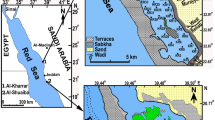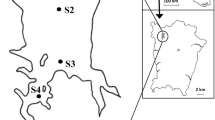Abstract
Macrofaunal and environmental data were collected from 97 sampling sites in ditches. In total 28 oligochaete taxa were found, 22 of which were determined to species level and further processed. About 33 environmental variables were measured at each site.
The resulting multivariate data set is described by three techniques, clustering (FLEXCLUS), ordination (CANOCO) and log linear regression (exponential and Gaussian).
In this way a detailed description of environmental preferences of the dominant species collected is given and also the possible species combinations which can be found under certain environmental circumstances.
Some advantages and disadvantages of the multivariate analysis techniques are reported. Detrended canonical correspondence analysis is a promising technique, especially in combination with clustering and regression analysis.
Similar content being viewed by others
References
Alvey et al., 1977. GENSTAT: a general statistical program Rothamsted Experimental Station, Harpenden, England.
Brinkhurst, R. O., 1964. Observations on the biology of lake dwelling Tubificidae (Oligochaeta). Arch. Hydrobiol. 60: 385–418.
Brinkhurst, R. O. & C. R. Kennedy, 1965. Studies on the biology of the Tubificidae (Annelida, Oligochaeta) in a polluted stream. J. Animal Ecol. 34: 429–443.
Bülow, T., 1957. Systematisch-autokologischen Studien an eulitoralen Oligochaeten des Kimbrischen Halbinsel. Kieler Meeresforsch. 13(1): 69–116.
Chekanovskaya, O. V., 1962. [The aquatic oligochaete fauna of the U.S.S.R.] Opred. Faune SSSR 78: 1–411 (in Russian).
Dumnicka, E., 1978. Communities of oligochaetes (Oligochaeta) of the River Nida and its tributaries. Acta Hydrobiol. 20(2): 117–141.
Dumnicka, E. & K. Pasternak, 1978. The influence of physicochemical properties of water and bottom sediments in the River Nida on the distribution and number of Oligochaeta. Acta Hydrobiol. 20(2): 215–232.
Dzwillo, M., 1966. Untersuchungen uber die Zusammensetzung der Tubificidenfauna im Hamburger Hafen. Abh. Verh. naturw. Ver. Hamburg (NF) 11: 101–116.
Gauch, H. G., Jr., 1982. Multivariate analysis in community ecology. Cambridge University Press, 298 pp.
Higler, L. W. G., 1977. Marofauna-cenoses on Stratiotes plants in Dutch broads. Verh. 11, RIN, Leersum, The Netherlands, 86.
Hill, M. O., 1979a. DECORANA — A FORTRAN program for detrended correspondence analysis and reciprocal averaging. Ecology and Systematics, Cornell University, Ithaca, New York.
Hill, M. O., 1979b. TWINSPAN — A FORTRAN program for arranging multivariate data in an ordered two-way table by classification of the individuals and attributes. Ecology and Systematics, Cornell University, Ithaca, New York.
Hiltunen, J. K., 1967. Some oligochaetes from Lake Michigan. Trans. Am. microsc. Soc. 86: 433–454.
Jonasson, P. M. & F. Thorhauge, 1976. Population dynamics of Potamothrix hammoniensis in the profundal of Lake Esrom with special reference to environmental and competitive factors. Oikos 23: 151–158.
McCullagh, C. L., J. A. Nelder, 1983. Generalized Linear Models. Chapman & Hall, London.
Moore, J. W., 1979. Influence of food availability and other factors on the composition, structure and density on a subarctic population of benthic invertebrates. Hydrobiologia 62: 215–223.
Pfannkuche, O., 1977. Oekologische and systematische Untersuchungen an naidomorphen Oligochaeten brackiger und limnischer Biotope. Diss. Univ. Hamburg, 138 pp.
Preston, F. W., 1962. The canonical distribution of commonness and rarity: part 1. Ecology 43: 185–215.
Särkkä, J., 1969. The bottom fauna at the mouth of the river Kokemaenjoki, southwestern Finland. Ann. zool. fenn. 6: 275–288.
Ter Braak, C. J. F., 1985. CANOCO — A FORTRAN program for canonical correspondence analysis and detrended correspondence analysis. IWISTNO, Wageningen, The Netherlands.
Ter Braak, C. J. F., 1986. Canonical correspondence analysis: a new eigenvector technique for multivariate direct gradient analysis. Ecology, in press.
Ter Braak, C. J. F. & C. W. N. Looman, 1986. Weighted averaging, logistic regression and the Gaussian response model. Vegetatio 65: 3–11.
Tongeren, O. van, 1982. FLEXCLUS, and interactive flexible cluster program (in prep.).
Verdonschot, P. F. M., 1983. Ecological characterization of surface waters in the province of Overijssel (The Netherlands). H20 16(25): 574–579.
Verdonschot, P. F. M., 1984. The distribution of aquatic oligochaetes on the fenland area of NW. Overijssel (The Netherlands). Hydrobiologia 115: 215–222.
Wachs, B., 1967. Die Oligochaeten Fauna der Fliessgewässer unter besonderer Berucksichtigung der Beziehungen zwischen der Tubificiden Besiedlung und dem Substrat. Arch. Hydrobiol. 63: 310.
Author information
Authors and Affiliations
Rights and permissions
About this article
Cite this article
Verdonschot, P.F.M. Aquatic Oligochaetes in ditches. Hydrobiologia 155, 283–292 (1987). https://doi.org/10.1007/BF00025661
Issue Date:
DOI: https://doi.org/10.1007/BF00025661




